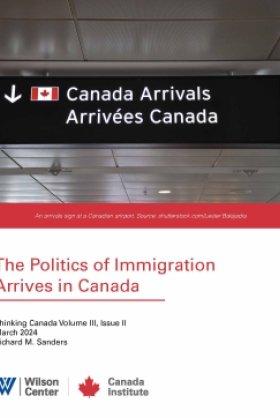Conference: Rebuilding the American Economy—One Heirloom Tomato at a Time
The food system of the United States is currently witnessing a remarkable shift, with the revival of small farms and artisanal producers working with restaurants, institutional food services, and retail outlets to make locally-sourced, sustainably-produced food more widely available. On March 4, 2011, the Wilson Center hosted a day-long conference to explore this critical conjuncture.
Overview
After a welcome from Allen Hance, keynoter Fred Kirschenmann opened the conference by highlighting issues of sustainability. Summarizing the history of how we have fed ourselves in the past, Kirschenmann traced our transition from a hunter-gatherer existence to the "neocaloric" era of today. "Stored, concentrated energy," he said, is at the core of our modern food system. Not only are fossil fuels necessary for the harvesting and transportation of food, but also the manufacture and distribution of fertilizers and pesticides. Some have even suggested that "we're eating oil," a situation Kirchenman considers unsustainable.
According to Kirschenmann, the food system of the future will not be able to depend on cheap energy and plentiful supplies of fertilizers, such as rock phosphates and potassium, which are being depleted at ever-increasing rates. With growing pressures on land and water, the transition to a new era in food production will require going beyond organic and local by fundamentally redesigning the food system. However, he noted, new levels of civic engagement as well as the "new idea spaces" developing around food give him hope for what might be possible in the future.
Co-keynoter Kate Clancy began her remarks by examining the concept of scale in the American food system "A properly managed system," she said, should self-organize on a scale that respects ecological limits and optimizes both economic and social efficiency." Solutions to complex problems must come from across scales in the system. This requires local efforts to interact with the scales both above and below it.
In the context of land use, Clancy went on, "people in any local area will find it extremely difficult to make an objective decision about farm land preservation because of competing interests and a lack of information." Today, local land-use decisions are made without a quantitative analysis of needs or resources of surrounding jurisdictions. She suggested that regions may be a better scale on which to address smart growth initiatives. At this level, food systems will look different across the country and over time, creating the need for "transition scenarios." Cross-scale communication on food system sustainability and other issues has, for example, been successful in New England and the Great Lakes region. Such cooperation in the future will allow for greater resilience to disruption and create an atmosphere in which "change is the norm."
Panel I: "Our Bodies, Our Food, Our Culture"
Erik Assadourian opened this panel by asking, "How do we shift dietary norms?" Because these norms are shaped by culture, he said, the culture itself must shift in order for any change in the food system to be successful. Citing the fact that hamburger was once associated with poverty and ill health, Assadourian argued that corporations have a large role to play in shaping a new food culture, along with government, education, the media, social movements, and social and cultural institutions. Religious communities, for example, can engage their members to work in "stewarding God's creation" through community gardens or farm outreach.
Such efforts have had real success, according to Devora Kimmelman-Block, who described how she was able to promote sustainable organic meat production while maintaining kosher practices. Such work has led her and others to rethink the meaning of kosher, literally defined as "fit for consumption," within the modern American food system. "Shouldn't food that is an expression of holiness demonstrate a healthy relationship between humans and nature?" Kimmelman-Block asked. By adding environmental stewardship and workers' rights to the established tenets of kashrut (the laws of keeping kosher), people will once again come to "treasure their meat."
Ed Bruske, a former Washington Post reporter and The Slow Cook blogger, became involved in changing the food system as a parent in the D.C. public schools. Reporting on the cafeteria in his daughter's elementary school, he found a distinct lack of fresh ingredients and healthy options in the meals provided by a food service company. Like Assadourian, Bruske stressed the education aspects of reshaping America's eating habits: "what is a sustainable food system unless you have sustainable eaters?" Bruske discovered, much to his chagrin, that after the schools improved their menus by including fresh local ingredient, students ended up throwing away much of the healthiest food.
Amy Trubek wrapped up the panel by presenting an overview of the concept of "terroir" and how it could help shape a new American culture around food. Terroir, or the "taste of place," she explained, is a concept that "informs practices and values around food and drink." When consumers and producers identify unique tastes and attach a value to them, they see food as more than just a commodity. Vermont's syrup and cheese producers, for example, worked to brand their artisanal products as distinct. They were aided in their efforts by a fascinating project in which students tasted multiple samples of syrup and cheese in order to develop a set of specific descriptive terms. In the process, they educated their own palates and widened their food horizons.
Panel II: The Challenges of Sustainable Food Production
Farmers in today's world are encountering a host of new challenges their predecessors did not see, according to Anthony Flaccavento. A shift is needed, he said, from the era of "empty-world economics," when arable land was plentiful and cheap, to "full-world economics." A century ago, there were fourteen acres of productive land per person, but now there are only 3.5. Moreover, today's farmers are dispersed in distant corners of the country at the ends of long supply chains, far from the concentrated markets where food is consumed. Producers must move closer to their markets, even if it costs more. The solution, he argued, is to recognize that "Americans can afford to pay more for food" that is sustainably raised.
Picking up on this theme, Rosalie Koenig noted that consumers must be the real drivers of sustainability. "A lot of the decision-making that happens in households affects what growers are going to do," she said. In coming years, farmers will face considerable difficulties, ranging from water scarcity to climate change. A particular problem is human capital: only one percent of the population are farmers. This is, according to Koenig, because young people today are simply not interested in the tough life of a farmer--a life without health insurance, with uncertain income and crushing debt.
Angela Miller provided a real-life example of how difficult that life can be. Despite her award-winning accomplishments as a goat farmer and artisanal cheese producer, she is still struggling to make a profit with her business and continues to depend on her "day job" in publishing to make ends meet.
Sustainable fishing, according to Angela Sanfilippo, presents similar problems. Her town, Gloucester, Massachusetts, "is the city that has fed New England for four hundred years." But today 85 percent of the seafood consumed in the United States is imported. The lengthening of supply chains and increase in international trade has not only devastated local fishing industries, but also harmed the environment. Overfishing has become a significant global problem, and ocean environments are also being threatened. Sanfilippo offered several solutions to these problems, including educating Americans about underutilized fish species and starting community-supported fisheries, such as the one she runs in New England.
Panel III: Feeding the Locavore
Erin Barnett, whose organization, LocalHarvest, connects family farms with consumers, opened the discussion of distribution. Through its online directory of local food producers (numbering almost 25,000) LocalHarvest allows farmers to market themselves easily at no cost. Barnett has seen rising demand for Community-Supported Agriculture (CSAs) across the country and a longing among consumers for a more personal connection to their food.
As a coordinator of the D.C. Farm to School Network, Andrea Northup was able to shed light on the integration of local food and school cafeterias in our nation's capital. The goal of the network is to promote health kids by improving access to healthy local foods and connecting them with where their food comes from. Picking up on the issue that Ed Bruske raised, Northup noted that engagement with food greatly increases the likelihood that kids will make healthy choices and actually eat nutritious food when it is offered to them.
University dining services, Rafi Taherian explained, present their own challenges, but there are ways in which large scale food service operators can successfully incorporate sustainable practices and procure food locally. Since few local producers can offer the quantities need for large institutional customers like Yale, Taherian has been compelled to cooperate closely with distributors and the wider university community to offer sustainable choices. At the same time, he is working with other universities along the Eastern Seaboard to create a buyers' network which may allow smaller producers to expand.
Restaurateur Dean Gold brought a gourmet perspective to the issue of local food consumption and distribution. He came to local and organic food, he said, not only because it was sustainable, but also because it provided the best tasting and freshest ingredients. In his restaurant, Dino, Gold uses local ingredients in combination with artisanal products from around the world. While such an approach is not a solution for the entire food system, he conceded, shopping and eating locally has many benefits.
For many in the United States, however, this is not an option. In contrast to diners at Dino, almost 24 million Americans lack access to fresh, healthy food, according to Ellen Holtzmann. Through its Pennsylvania Fresh Food Financing Initiative, her organization has coordinated public and private business financing to make fresh food available in the tens of thousands of local corner and grocery stores that play an important role in community life for many Americans.
But is local food ultimately the answer? Not necessarily, said the panel's final speaker, Pierre Desrochers. The development of a global food system that produces food in large quantities and transports it across the world, he pointed out, has helped to mitigate the severe effects of famine and food insecurity for millions. Moreover, global suppliers are essential in providing an uninterrupted food supply to regions with limited growing seasons.
Panel IV: Food and Finance
As the local food movement evolves from a niche market to a broader industry, it raises questions about the economic implications for small and large farmers. Sustainable and healthy food, Andrew Caplin suggested, is a market with a large opportunity for growth. There is also the potential for a "food information health complex" that would create jobs and business catering to the growing interest in sustainably grown, healthy food. But given changing norms and food fads, Caplin was skeptical that "experts" really know what agricultural practices and food science are most conducive to health.
Sustainable agriculture sent up different kinds of red flags for agricultural economists David Swenson and Stephen Vogel. Studying the viability of local food production in one region of the United States. Swenson found that there are limits to the economic opportunity afforded by selling food locally, the most important of which is the need for proximity to a densely populated metropolitan center. Vogel echoes this concern and quantified it, noting that small farms struggle to achieve profitability, particularly because they are less able to sell to intermediaries and rely more heavily on direct-to-consumer sales.
Insofar as they avoid "the middleman," such sales may be more profitable to growers than marketing wholesale, but, as Gary Matteson pointed out, the markets are smaller. In his view, the biggest gains for small farmers in coming years will come from layering multiple businesses into farms. "Farmers need to think of themselves as rural entrepreneurs," Matteson said. Among the options he mentioned are "agrotainment"—creating family-friendly farms and orchards to attract visitors. But some of the most profitable businesses, he noted, may not be connected to the farm itself.
Speakers
Erik Assadourian
Erin Barnett
Ed Bruske
Andrew Caplin
Kate Clancy
Pierre Desrochers
Anthony Flaccavento
Allen Hance
Devora Kimelman-Block
Fred Kirschenmann
Rosalie Koenig
Gary Matteson
Angela Miller
Andrea Northup
Angela Sanfilippo
David Swenson
Rafi Taherian
Amy Trubek
Stephen Vogel
Hosted By

Environmental Change and Security Program
The Environmental Change and Security Program (ECSP) explores the connections between environmental change, health, and population dynamics and their links to conflict, human insecurity, and foreign policy. Read more
Thank you for your interest in this event. Please send any feedback or questions to our Events staff.










